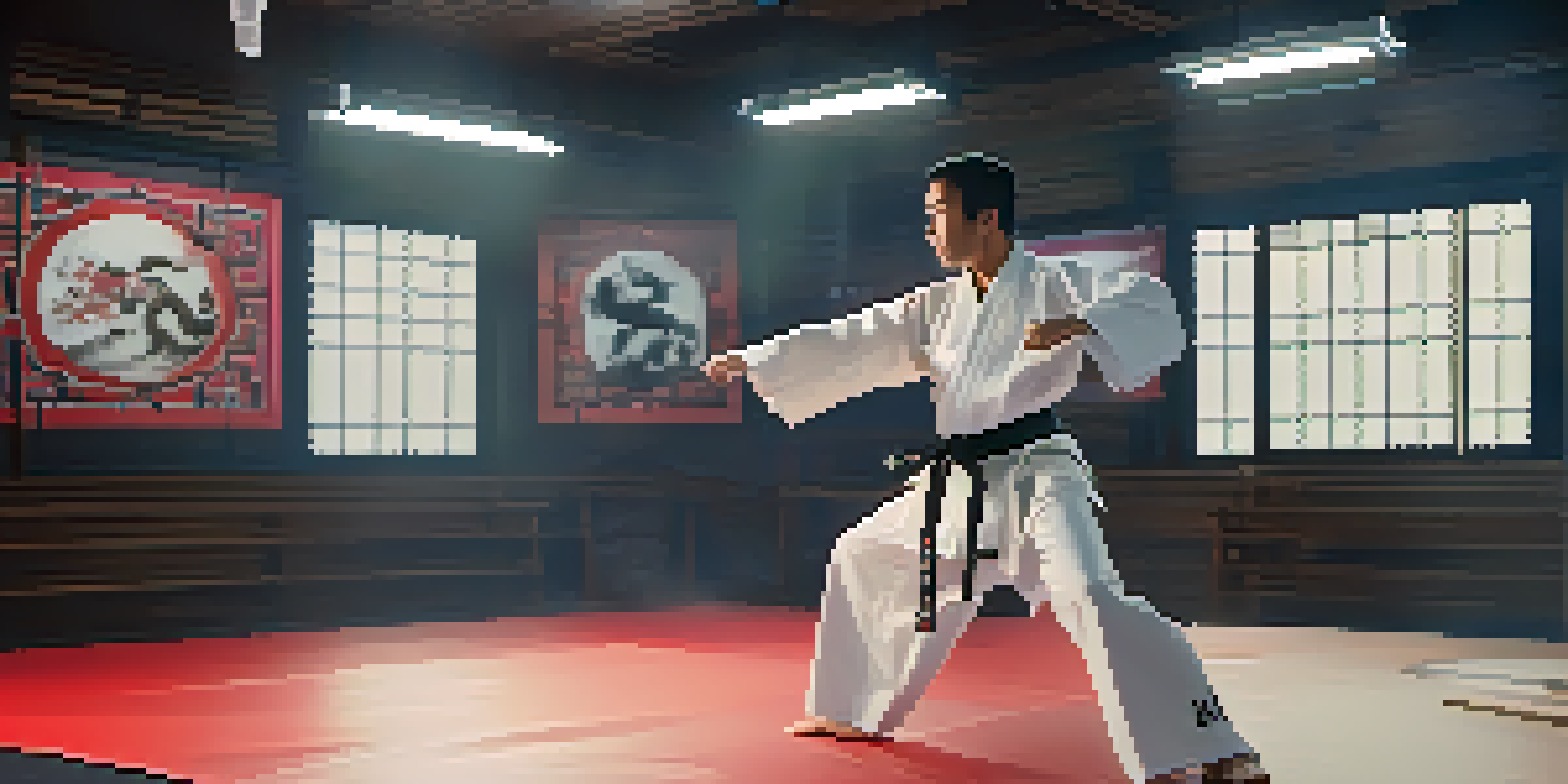The Role of Technology in Modern Martial Arts Competitions

The Evolution of Martial Arts with Technology
Martial arts have a rich history, but in recent years, technology has transformed how they are practiced and competed. From ancient techniques to modern training methods, technology has played a crucial role in this evolution. Competitors today not only rely on their physical abilities but also on digital tools to sharpen their skills and strategies.
The future belongs to those who believe in the beauty of their dreams.
For instance, video analysis software allows athletes to review their performances frame by frame, identifying areas for improvement. Coaches can now create detailed breakdowns of techniques, helping fighters refine their moves. This blend of tradition and innovation ensures that martial artists can stay competitive in an ever-evolving landscape.
As technology continues to advance, it paves the way for new forms of martial arts competitions, merging age-old practices with cutting-edge tools. This evolution showcases the adaptability of martial arts, proving that even the most traditional of disciplines can embrace modernity.
Wearable Technology: Tracking Performance
Wearable technology has become a game-changer in martial arts training and competitions. Devices like fitness trackers and smartwatches allow martial artists to monitor their heart rate, calories burned, and even their sleep patterns. This data is invaluable, as it helps athletes understand their bodies better and optimize their training regimens.

For example, a fighter might discover that their heart rate spikes during certain techniques, indicating a need for improved conditioning. This insight enables them to tailor their workouts for maximum efficiency. As a result, athletes can not only enhance their performance but also reduce the risk of injury by recognizing their physical limits.
Tech Transforms Martial Arts Training
Technology enhances training methods, allowing martial artists to leverage tools like video analysis and wearables for improved performance.
The integration of wearables in martial arts extends beyond individual training; it can also foster a sense of community. Many athletes share their data with peers and coaches, creating a supportive environment focused on growth and improvement.
Virtual Reality: A New Training Frontier
Virtual reality (VR) is making waves in the martial arts world, offering immersive training experiences that were previously unimaginable. With VR, martial artists can practice techniques in a simulated environment, allowing them to experiment with movements without the risk of injury. This technology can be particularly beneficial for beginners, who can safely explore various styles and techniques.
Technology is best when it brings people together.
Moreover, VR training can enhance mental preparedness for competitions. Athletes can rehearse their routines or visualize their opponents in a controlled environment, boosting their confidence. The combination of physical practice and mental visualization can lead to significant improvements in overall performance.
As VR technology becomes more accessible, we can expect to see it widely adopted in martial arts schools and training facilities. This innovative approach not only enriches the training experience but also prepares athletes for the pressures of competition.
Judging and Scoring: The Rise of Technology
In martial arts competitions, accurate judging is crucial for fair outcomes. Technology is increasingly being utilized to enhance the judging process, ensuring that every move and point is accurately recorded. Electronic scoring systems, for example, can provide immediate feedback on a competitor's performance, removing the subjectivity that sometimes accompanies human judges.
This shift not only instills confidence in competitors but also in audiences, as they can trust that the results are based on precise data. Additionally, some competitions are even incorporating video replays to review controversial decisions, adding another layer of fairness to the event.
Social Media Connects Global Community
Social media platforms enable martial artists to showcase their skills, build personal brands, and foster a supportive global community.
By embracing technology in judging and scoring, martial arts organizations can maintain the integrity of their competitions while also elevating the viewing experience for fans. This transparency is essential for the growth of martial arts as a mainstream sport.
Social Media and the Global Reach of Martial Arts
Social media has become a powerful tool for martial artists to showcase their skills and connect with a global audience. Platforms like Instagram and YouTube allow athletes to share training videos, tutorials, and competition highlights, building their personal brands and engaging with fans. This visibility can lead to sponsorships and opportunities that might not have been available in the past.
Moreover, social media fosters a sense of community among martial artists worldwide. Practitioners can share tips, experiences, and motivation, transcending geographical boundaries. This interconnectedness not only enhances individual growth but also promotes the sport on a larger scale.
As martial arts continue to gain popularity, the role of social media will only grow. Athletes who leverage these platforms effectively can inspire others while also advancing their own careers in the sport.
Online Training: Access to World-Class Instruction
The rise of online training platforms has revolutionized how martial artists learn and improve their skills. Athletes can now access instructional videos, live classes, and one-on-one coaching from world-class instructors without ever leaving their homes. This accessibility democratizes training, allowing anyone, regardless of location, to learn from the best.
For many martial artists, this means having the opportunity to explore different styles and techniques that may not be available in their local area. Online resources can supplement traditional training, offering diverse perspectives and methods to enhance their practice. Moreover, athletes can revisit lessons at their own pace, fostering deeper understanding and mastery.
Online Learning Expands Access
Online training platforms democratize martial arts education, giving athletes access to world-class instruction regardless of location.
As online training continues to evolve, the potential for personal growth in martial arts is limitless. This trend not only empowers individuals but also enriches the martial arts community as a whole.
The Future of Technology in Martial Arts
Looking ahead, the role of technology in martial arts will only expand. Innovations in artificial intelligence, machine learning, and data analytics are set to revolutionize how athletes train, compete, and recover. Imagine AI-driven coaching that provides real-time feedback during practice sessions, or advanced analytics that help fighters optimize their strategies based on opponent data.
Furthermore, as technology continues to integrate into the fabric of martial arts, we can expect to see enhancements in safety measures as well. Smart protective gear could monitor impacts and provide data to trainers, reducing the risk of injuries and prolonging athletic careers.

Ultimately, the fusion of technology and martial arts will create a new era of training and competition. As athletes embrace these advancements, they will be better equipped to reach their full potential and redefine what is possible in the sport.